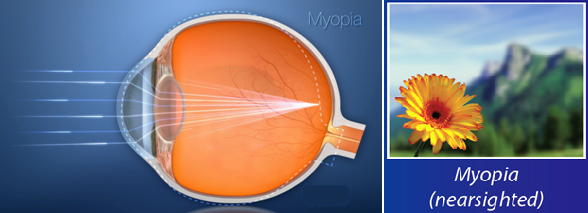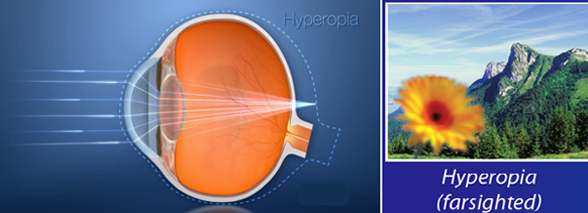Short-sightedness. Far-sightedness. Astigmatism

SHORT-SIGHTEDNESS
is a common eye refraction defect, where the light and the object's image are focused in front of the retina, because of too strong light breakage. This causes distant objects to be blurred while close objects appear normal.
Short-sightedness can be inherited – the children of short-sighted parents usually also have the same refraction defect. In the case of hereditary short-sightedness, the intensive load on the eyes of long-term TV watching, work or computer games, inappropriate lighting of the work area, reading while lying down have a significant impact on the eyes. Chronic diseases and compromised immunity of the body are very important for the development of the disease.
For a short-sighted individual distant objects appear blurred and they tend to narrow their eyelids to try to bring the objects into focus, which leads to the ocular muscles becoming strained and becoming tired very quickly. This is turn leads to shimmering in the eyes, eye pain associated with eye movement or even headache.
If short-sightedness develops early, it tends to progress faster, especially during adolescence, because of the growing eyeball. Once adulthood is reached (at 18-20 years old), there is usually no further progression of the disease. If short-sightedness progresses rapidly (by more than 1.5D per year), alterations in the eye-ground may develop. In such cases even glasses do not ensure good vision. Short-sightedness is not curable. Vision can be improved by glasses with minus powered lenses or contact lenses. These means improve vision, alleviate eye pain and headache ensuring a sufficient quality of life. If a patient does not want to or cannot wear contact lenses, if they are unhappy wearing glasses or the glasses interfere with everyday activities, the excimer laser can be used for vision correction. After this surgery the patient is able to see distant objects without any other corrective means. However, laser surgery can be used if the refraction is stable for one year at least and there are no other ocular diseases present. In case of high-degree myopia, when laser surgery is contraindicated, intraocular correction can be applied with intraocular implantation of an artificial lens, which improves vision significantly.
FAR-SIGHTEDNESS
is the eye refraction defect in which light is focused behind, instead of on the retina. This results in close objects appearing blurred, while far objects may appear normal. Almost all new-born babies are far-sighted.

Later as the child develops, far-sightedness resolves and normal eyesight develops. The eyeball shape and characteristics of its light breaking media are hereditary. Young far-sighted individuals who have a mild refraction defect can initially adapt their vision because of accommodation (ability to see objects from different distances): the ocular lens becomes more convex, which increases its refraction ability improving the object image. Such individuals do not experience any vision disorders before reaching the age of 40 years; their vision can be up to 100 percent and they are not even aware that they are far-sighted. This is known as latent far-sightedness. In case of moderate or severe far-sightedness when eye accommodation is insufficient, close objects appear blurred. This is known as actual far-sightedness. In such case the eye has to accommodate all the time to ensure sharp vision, therefore it rapidly gets tired and different signs of accommodative asthenia (accommodative fatigue) occur – the image merges, the eyes get tired quickly, the eyes are painful and headaches develop. The person complains of increased sensitivity, eyelid twitching, redness of the eyes and the edges of the eyelids in small children, which can lead to strabismus development. Far-sighted eyes tend to develop chronic conjunctivitis, blepharitis and glaucoma.
Far-sightedness unlike short-sightedness does not progress.
Far-sightedness can be corrected with glasses using convex (plus) lenses or with contact lenses. These means improve vision, eye pain and headaches are alleviated ensuring a good quality of life. Surgical vision correction is also possible – an eximer laser is used.
In order to prevent far-sightedness it is very important to check children's vision regularly, twice per year, ensure healthy nutrition, follow a good daily routine and avoid stress.

ASTIGMATISM
is a condition when two refractions of different degree are present in one eye. It is a type of refractive error in which the eye does not focus light coming from a single source into a single point of the retina, therefore the image is blurred, deformed or has a shadow.
This is known as pointless eye. Astigmatism can affect both short-sighted and far-sighted eyes.Astigmatism is usually caused by irregularities in the shape of the cornea (irregular convexity of the corneal surface). Mild (up to 0.75 D) astigmatism is reported rather often, it does not interfere with vision and is known as physiological. The higher degree astigmatism is usually congenital or inherited. Sometimes astigmatism develops because of corneal injury, scars, or as a result of eye surgery.
Individuals suffering from astigmatism often complain of eye fatigue, not only after activities that require minute observation but also after intensive observation of distant objects (performance, film, driving a car, because their vision is blurred if they do not use glasses. They also experience headaches, inflammation of the eyelid edges and conjunctiva.
Astigmatism may be corrected with cylinder lens eyeglasses, for which the exact rotation angle is very important, as well as with soft toric or hard contact lenses. Astigmatism should be corrected in childhood, because it is difficult to adapt to cylinder glasses later and complete vision improvement may not always be achieved. The prescribed glasses should be worn continuously for a long time. Contact lenses can be helpful in case of severe astigmatism, however, such correction options are limited. Correction of astigmatism with the excimer laser is much more effective. After laser surgery the refractive power of the cornea is altered, leading to significantly better vision.

